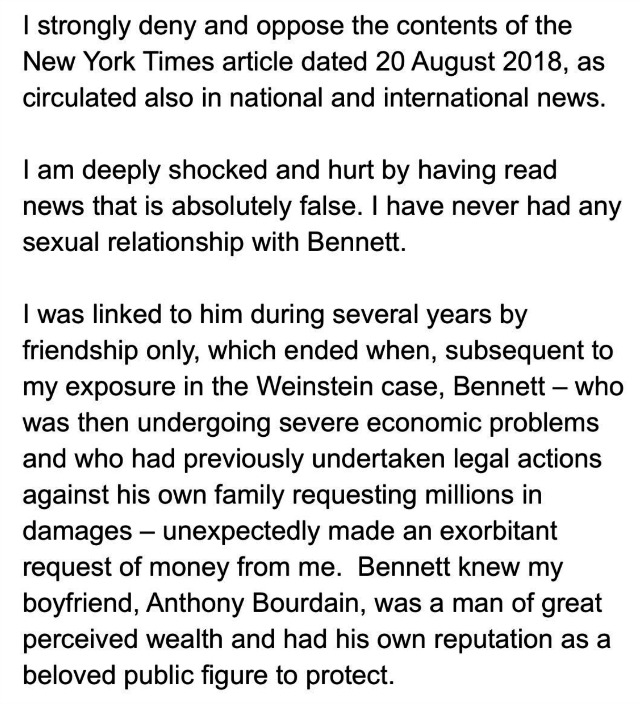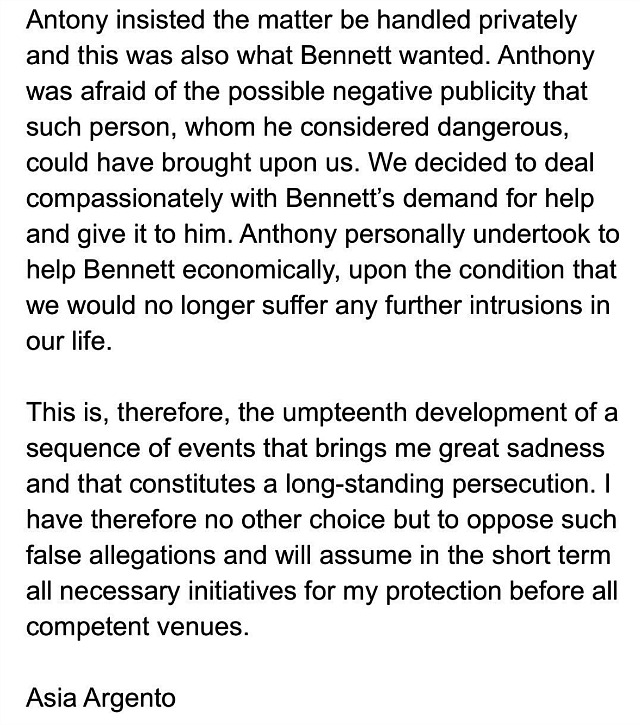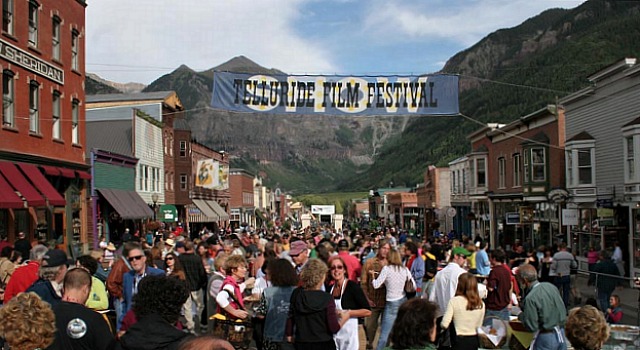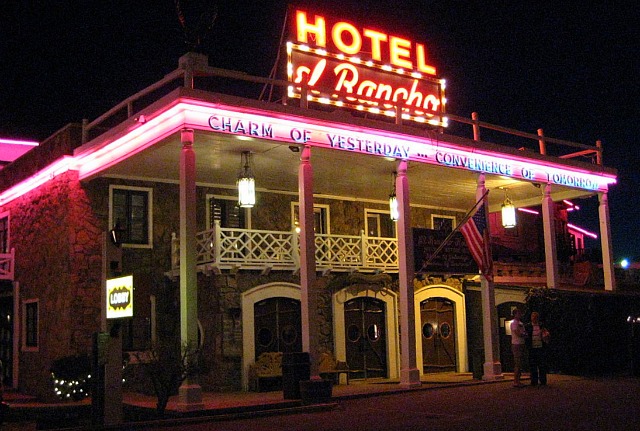


Sink into that Hold The Dark vibe, that feeling of fog and dread, Jeffrey Wright‘s getting-grayer-and-grayer beard, the atmosphere of damp, drippy snow covering everything, “oowwwwooooohhh!”
A statement from Asia Argento about that N.Y. Times sexual assault-and-payoff story was posted this morning by New York‘s Ashar Ali. She denies she ever had any sexual encounter or relationship with Jimmy Bennett, claims that Bennett is/was a financially unstable shakedown artist and asserts that she and late boyfriend Anthony Bourdain (whom she names as “Antony” at one point in the statement) decided to pay Bennett off anyway to keep the allegedly spurious allegation out of the press.
Who gives an alleged shakedown artist over $300K? And what’s that final paragraph about? N.Y. Times columnist Bari Weiss doesn’t address it, but her general take on L’Affaire Argento is worth reading.


Yesterday HE’s Paranoid Bush tweeted that someone like myself “could write an entertaining if deeply inane Bill Simmons-y article about how the major romcom actresses of the 1990s, and how no one back then would have predicted Sandra Bullock would have the most significant staying power.”
At 54, Bullock has lasted longer in the box-office limelight and is still a fairly big draw, but romcom-wise all actresses age out. Most female romcom (or straight romance) stars enjoy a 10 to 15-year run until they hit 40 or thereabouts, and then their younger replacements move in.
Bullock became a marquee name in the mid ’90s with Speed, and then built her romcom (or straight romantic) brand with While You Were Sleeping, Two If by Sea, Hope Floats, 28 Days, Miss Congeniality, Divine Secrets of the Ya-Ya Sisterhood, The Lake House and The Proposal. Since that 2009 film she’s been more of a comedy star with occasional dramatic detours.
The top three ’90s romcom stars were Bullock, Meg Ryan and Julia Roberts. Ryan torpedoed herself with bad plastic surgery, of course. Roberts’ ’90s romcom run lasted from Pretty Woman (’90) to Runaway Bride (’99). She eventually graduated into somewhat older or middle-aged woman roles (mothers, detectives, business executives) starting around a dozen years ago.
Bullock, Ryan and Roberts’ contenders were Alicia Silverstone, Julia Stiles, Drew Barrymore and Cameron Diaz.
Silverstone peaked with Clueless, of course, and that was pretty much it. Stiles has a three-year romcom run in the late ’90s with 10 Things I Hate About You, Down to You and Save the Last Dance. Barrymore’s run was a late ’90s-to-late aughts thing — The Wedding Singer, Home Fries, Never Been Kissed, Riding in Cars with Boys, 50 First Dates, Lucky You, He’s Just Not That Into You. Diaz launched in the mid ’90s with The Mask, My Best Friend’s Wedding and There’s Something About Mary and kept it going into the early to mid aughts with The Sweetest Thing, In Her Shoes and The Holiday.
I for one am keen to see Noah Baumbach‘s untitled divorce movie, which Netflix will release…you tell me. Costar Ray Liotta provided a capsule synopsis in a Business Insider interview that ran a couple of months ago.
“Yeah…I’m a lawyer in it,” Liotta said. “Adam Driver and Scarlett Johansson‘s characters are going through a divorce, he comes to me and I’m a lawyer who explains all these ways we can get stuff out of her in the divorce, and he’s, like ‘No, that’s too aggressive.’ So he ends up going to court, and there he realizes that Scarlett has a lawyer who’s really aggressive. So then he’s, like, ‘Oh, shit’ and he comes back to me to represent him.”
That Norman Mailer quote: “You don’t know a woman until you’ve met her in court.”
Principal photography happened between January and March earlier this year. Laura Dern also costars.
I noted last year that for a majority of journos with tight travel schedules and a pile of deadlines, the four-day Telluride Film Festival is actually a three-day if not a two-and-a-half-day festival. Which means that out of 30 films typically scheduled, go-getters can maybe catch 14 or 15, tops. And that’s if you’re really aggressive about it. If you’re only moderately aggressive you’ll wind up seeing 10 or 12.
The fest doesn’t begin until mid-Friday afternoon (i.e., post Patron’s Brunch), which affords an opportunity to see two or three films during the remainder of that day. Three or four pics are catchable on Saturday and Sunday for a likely total of 10 or 11 by Sunday midnight, and maybe a couple more on Monday before leaving town. And you have to review everything as you go along.
On top of which Telluride often schedules the highest-interest films against each other so you’re always missing out on Peter in order to see Paul. On top of which are the dinners and parties.

I’m given to understand that the following films are locked for Telluride ’18: Alfonso Cuaron‘s Roma, Damien Chazelle‘s First Man, Mike Leigh‘s Peterloo, Orson Welles‘ The Other Side of the Wind, Yorgos Lanthimos‘ The Favourite, Olivier Assayas‘ Non-Fiction, Marielle Heller‘s Can You Ever Forgive Me?, Jason Reitman‘s The Front Runner, David Lowery‘s The Old Man and the Gun, Yann Demange‘s White Boy Rick, Karyn Kusama‘s Destroyer, Joel Edgerton‘s Boy Erased, Pawel Pawlikowski‘s Cold War and Hirokazu Kore-eda‘s Shoplifters. (14)
HE solution to Telluride gridlock: With everyone arriving on Thursday afternoon, the festival should begin on Thursday night with hottie screenings at all the venues (Chuck Jones, Werner Herzog, Palm, Galaxy, Pierre, Backlot) starting at 7 pm and then again at 9:30 or 10 pm. Hell, stage a midnight screening or two. And then more hottie screenings on Friday morning starting at 8:30 or 9 am. Those who wish to attend the Patrons picnic could squeeze it in around 11 or 11:30 am, but a full load of screenings would continue for those who’d rather catch films than eat.
By launching on Thursday night and starting screenings early on Friday morning, four or five fresh opportunities to catch the must-sees would be on every visiting critic’s plate. And for those who might prefer to take a more leisurely, old-time approach, they can still start things off with the picnic and then the first Patrons screening at the Chuck Jones at 2:30 pm, and no harm done.
Now doesn’t that make sense?
Less than a month into Donald Trump‘s presidency, Meryl Streep tore into that sociopathic blowhard during a wonderfully feisty speech at a Human Rights Campaign event in Manhattan on Saturday, 2.11.17. And this was more than eighteen months ago — things are much worse now.
If any of the apparent female contenders for the Democratic president nomination (Elizabeth Warren, Kamala Harris, Kirsten Gillibrand) were to deliver a speech today with even half of Streep’s passion, oratorical precision and pizazz, she/they would have the nomination all but sewn up. But of course, none of them are in Streep’s class. Aspiring but no cigar.
If Streep were to run for president…I’m just saying. We had a former B-level actor in the Oval office in the ’80s. We have a reality TV huckster in the White House now. What about an Oscar-winning actress? Why not?
The SJW admonishers and virtue signallers were out in full force yesterday. When an ethical-moral issue surfaces (such as Asia Argento having reportedly paid off a now 22-year-old actor over an apparent issue of sexual assault when he was a minor, and her apparent #MeToo hypocrisy in having done so), the Twitter police immediately huddle and establish the p.c. perimeters, usually within two or three hours of such a story breaking.
Soon after the Argento story popped last weekend, the tut-tutters had articulated the proper public (i.e., social media) posture. Once that process was completed, posting a view that diverged even slightly from their own was likely to attract slings and arrows.
In my case I was pummelled for suggesting that the victim in question had reacted to Argento’s alleged sexual manipulation in a way that diverged from the generally understood behavior of most teenaged actors, from my own teenaged experience and from that of Mickey Rooney. I basically expressed the same view as a certain SNL skit on a similar subject. In almost no time I became in some circles the poster boy for the “wrong” way to assess the Argento matter. I show you the times in which we live.
Ben Brafman, attorney for accused rapist and former Hollywood hotshot Harvey Weinstein, released a statement today about an 8.19 N.Y. Times report about Asia Argento having paid off a 22 year-old ex-actor after he accused her of sexual assault five years ago, when he was 17:
“This development reveals a stunning level of hypocrisy by Asia Argento, one of the most vocal catalysts who sought to destroy Harvey Weinstein. What is perhaps most egregious, is the timing, which suggests that at the very same time Argento was working on her own secret settlement for the alleged sexual abuse of a minor, she was positioning herself at the forefront of those condemning Mr. Weinstein, despite the fact that her sexual relationship with Mr. Weinstein was between two consenting adults which lasted for more than four years.
“The sheer duplicity of her conduct is quite extraordinary and should demonstrate to everyone how poorly the allegations against Mr. Weinstein were actually vetted and accordingly, cause all of us to pause and allow due process to prevail, not condemnation by fundamental dishonesty.”
In the interest of saving a few bucks, next week I’ll be driving to Telluride with hotshot Variety music reporter and AARP magazine film critic Chris Willman. We’ll begin our return trip on Monday, 9.3.
The Telluride Film Festival begins on Friday, 8.31, but you have to get your pass, buy groceries and get squared away the day before. We’ll be departing in the early morning of Wednesday, 8.29. The idea is to reach Gallup, New Mexico by dusk or thereabouts, and then cruise easy to Telluride the next day or Thursday, 8.30.
Chris has made this trip this several times and is therefore The Authority, but this is how it seems to me:

El Lay to Gallup is an estimated 9 and 1/2 hours, according to online authorities. Obviously the idea is to avoid L.A. rush hour traffic. That means leaving no later than 7 am or waiting to leave at 10 am. 7 am departure = 5:30 or 6 pm arrival with allowances for an extra 90 minutes for gas, rest stops, maybe a lunch. A 10 am departure = 8:30 or 9 pm arrival in Gallup with same allowances.
Right now we’re both leaning toward an early morning departure. Our current plan is to stay in Gallup’s Econo-Crap Lodge. Seriously, we’re looking at the El Rancho.
The Gallup-to-Telluride trip is estimated at 3 hours, 45 minutes. Call it four, four and a half hours with gas stops and whatnot. Leave at 9 am, arrive at 1:30 pm.
The webmasters of the Telluride Film Festival website are still running last year’s data, and the ’18 gathering begins 12 days from now. Hubba hubba, get the lead out, etc.
Vulture‘s Hollywood guy Kyle Buchanan is the new “Carpetbagger” for the New York Times. He’ll be the fourth to carry that brand, the previous three being Cara Buckley, Melena Ryzik and the late, great David Carr.
The carpetbagger term fit Carr because he was basically a brainy, independent-minded New York guy (lived in Montclair) who never really played the Hollywood game. Buchanan, on the other hand, has been playing it all along, Los Angeles-based in more ways than one, schnorring and observing his way through the six-month-long award season with the rest of us.
Buchanan will launch his Times coverage with the early fall film festivals — Telluride, Toronto, New York. This morning I asked Buchanan who will succeed him as the new Vulture award-season person. “To be determined,” he said.
It always bothered me when Buckley and Ryzik would declare that Oscar season begins in December….no! It begins with Telluride and ends with the Oscar telecast, which this year will take five and a half months. Get that through your heads.
Buchanan quoted by Indiewire‘s Anne Thompson: “I’m excited to cover Hollywood out of Hollywood. Mostly, though, I hope to bring the same wit and curiosity to the job that my predecessors did. Yes, there are a lot of silly things about the Oscars — and trust, I love covering the silly things too — but I believe that when you really understand awards season, this is a continually exciting and surprising beat where the stories lend us a prism through which we can better know the world. Even a simple snub isn’t always just a snub: It can tell us a lot about what we canonize as a society and reveal where our blind spots still lie.”
Well said, Kyle. This is what L.A. Daily News critic and Oscar disser Bob Strauss is either incapable of understanding or refuses to consider.
Are The Matrix Reloaded and The Matrix Revolutions (both released in ’03) the least satisfying, most ruinously awful sequels ever made? Not just because they blew chunks on their own terms, but they tarnished the reputation of The Matrix (’99), the perfect, almost-jewel-like original that launched the mini-franchise.
This led me to contemplate a list of stand-alone films that never should have given birth to a sequel or sequels or a spinoff TV series. The Jaws movies after Steven Spielberg‘s 1975 original. The Jurassic Park sequels. The Hangover sequels. The Terminator sequels. A voice is telling me Jim Cameron should have left Avatar alone and not gone on to commit to…what is it, three sequels? But of course everyone has written about these.
What about the reverse? What first-rate films that never inspired any follow-ups should have spawned a sequel or cable series? I honestly would’ve loved to see a Michael Clayton series on Showtime, Hulu or HBO, perhaps not with George Clooney in the title role but then again why not? He arguably delivered his career-best performance in Tony Gilroy’s 2007 legal thriller, and the film itself is surely his finest ever. I would’ve been down with a mid ’80s TV series about the continuing legal adventures of Frank Galvin, the wounded Boston attorney played by Paul Newman in The Verdict.
Which others?